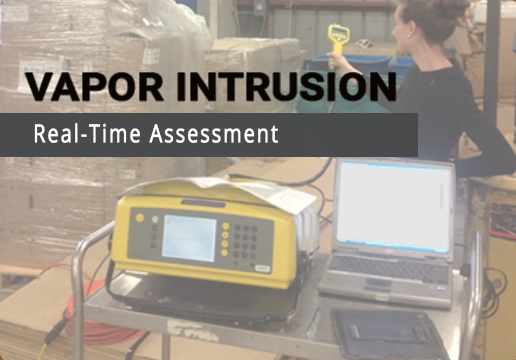This is the first in a series of posts on vapor intrusion, which refers to the migration and entry of volatile organic chemicals (VOCs) into the indoor air of buildings from underlying or nearby contaminated soil or groundwater, resulting in risk to occupant health and safety.
Vapor intrusion (VI) has been a recognized health and safety risk connected to contaminated properties for several decades. The U.S. EPA’s first technical guidance on VI assessment and mitigation was published in 2002, and VI has been a standard consideration in property due diligence and environmental site assessments for many years.
Approaches to Vapor Intrusion Assessment
Despite the long-standing awareness of VI risk and the thousands of sites that have been identified with potential VI concerns, little has improved in the way most of these sites are investigated and mitigated. A traditional VI assessment approach is to collect samples of soil vapor and/or indoor air, wait several weeks to get results from the laboratory, then repeat the sampling to address new questions and uncertainties in the data. This can be a drawn-out process that can take months, if not longer – an undesirable situation when human health, environmental impact, or business interests in the property are at stake.
As technical approaches to VI assessment have evolved, advanced and innovative tools to accelerate and improve VI assessment and mitigation are being implemented over the more traditional, slow, and oftentimes inconclusive methods. We understand our clients’ needs to mitigate uncertainty and reduce risk as quickly as possible.
Real-Time Vapor Intrusion Results
A leading example of improved approaches to VI assessment is to obtain results in real time using advanced field analytical instruments. The benefits of this approach to obtain instantaneous investigation results include:
- Fast-track identification of VI concerns
- Better, clearer knowledge of where and how VI is occurring including potential preferential VI pathways
- Rapid insight into effective short-term immediate action and long-term VI mitigation methods
- Streamlined, turn-key solutions that save time and money.
Real-time VI assessments rapidly reduce uncertainties associated with properties that may be environmentally impaired, allowing owners to make well-informed decisions. Similarly, regulators have embraced real-time VI assessments because of how quickly risks can be evaluated and mitigating actions taken, if appropriate.
Future posts in this series will address additional tools and methods to improve vapor intrusion assessment and mitigation, including soil profiling, and the importance and influence of building HVAC systems in vapor intrusion investigations.
For more detailed technical information and implementation of real-time VI assessment, please refer to our white paper available when you complete the form below.
For over two decades, Sanborn Head has been a pioneer and first adopter of improved tools and methods for VI assessment and mitigation. Our VI practitioners have helped develop and promote advanced data collection techniques and mitigation methods through our contributions to the Interstate Technology & Regulatory Council (ITRC) VI guidance, teaching, and scores of presentations, webinars, and papers for environmental conferences and webinars. Beyond technical expertise, we provide our clients with strategic advice and solutions grounded in practical experience.
Posted In: Articles
Tagged In: Vapor Intrusion





